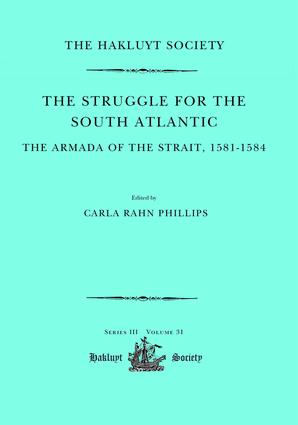The latest Hakluyt Society publication, The Struggle for the South Atlantic: The Armada of the Strait, 1581-84, edited by Professor Carla Rahn Phillips, documents the story of The Armada of the Strait which sailed under Don Diego Flores de Valdés in 1581–4. The armada set out from south-western Spain in the fall of 1581, with twenty-three ships and 3,500 people on board. During its three years’ voyage, hundreds of people would drown in shipwrecks and hundreds more perished from disease and privation.
The first of such shipwrecks occurred in October 1581, just a few days after the departure of the armada from Sanlúcar de Barrameda, bound for Brazil. In this post, Professor Rahn Phillips introduces us to one of the most thrilling passages of the Relación of chief scribe Pedro de Rada. The excerpt is a translation from fols 4r–5r of the original manuscript, now held in the Huntington Library [1].
– Join the Hakluyt Society on www.hakluyt.com –
[f. 4r] … Tuesday, the 3rd of October [1581], the eve of San Francisco, when we had sailed about 35 leagues from San Lucar, there began to be such strong wind from the south and south-west, with much shifting of the cargo, and things looked bad, so that it was indispensable that the armada take down its sails and heave to, until Friday, the 6th of the aforesaid, when the weather had such force that the galeaza capitana had to jettison some things, which was done.
And the weather worsened so much on this day that eight navios from the armada could not be seen. And the next day, Saturday the 7th, we found ourselves so off course that, though we were not ten leagues from the Baya de Cadiz, the pilots did not know where they were, and thus there were a thousand variations amongst them, until the capitana saw the land of Rotta downwind, and we found ourselves blown so far to leeward that, given the force of the weather, it was greatly feared that we would not be able to enter the Bayya de Cadiz.
And thus we sailed toward it with great difficulty, close to the wind because the wind and sea were excessive, the galeaza capitana entering with another fifteen naos that were going with her. In sight of the city of Cadiz, the nao named Nuestra Senora de Guia whose captain was Martin de Quiros, went to the bottom in a trice, and all who were on her drowned, which was the greatest misfortune to see without being able to succour even a single man, although it was four in the afternoon; and 150 men and some women and children settlers were on this nao.
[f. 4v] This day, the navio named Nuestra Señora de Buena Esperanza, on which Pero Estebanez de las Alas sailed as captain, was lost near Roctta, which it could not get round. The captain himself and one hundred other persons from this navio were drowned. This same day the navio named San Miguel was lost, whose Captain Hector Abarca was drowned with another eighty persons. This same day the nao named Sancti Yspiritu was lost near the Rio del Oro in El Picacho. The captain and owner was Juanes de Villaviciossa Lizarza, who had remained in San Lucar and did not go on the expedition, because he was given too little money as subsidy; and Captain Alvaro Romo sailed in her and was drowned with another 120 persons.
The nao almiranta, in which Diego de la Rivera sailed, entered into the bay the next day, Sunday the 8th of October, after nearly being lost next to Arenas Gordas. Another two naos entered San Lucar with great difficulty, one in which Don Alonso de Sotomayor sailed, and the other with Captain Gutiere de Solis. The latter was taken to the Cassa de la Contratacion in Seville under arrest, because he had left the nao before it entered into the port. Another nao entered Guelba, with its captain Jodar Alferez.
This incident and misfortune caused great pain and grief to all in the armada, and General Diego Florez felt it very much, because, besides the loss of so many people, provisions, artillery, and other munitions, many captains and [f. 5r] high-ranking dependents of his were drowned.
[1] Note that the spelling of place names, etc. follows the original manuscript. Spanish words that should have accents do not have them in the original text, so they are not added in the translation. Ship names and types are, however, placed in italics, for the sake of clarity if not consistency.
Carla Rahn Phillips, Union Pacific Professor in Comparative Early Modern History (Emerita), retired from the University of Minnesota in 2013. She has published numerous books, articles, and book chapters on the social and economic history of Spain and its maritime connections in the early modern world, including Six Galleons for the King of Spain (1986), The Treasure of the San Jose (2007), and (with William D. Phillips Jr.), The Worlds of Christopher Columbus (1993), and A Concise History of Spain (2010, 2nd ed. 2015).
@HakluytSociety – Become a member at www.hakluyt.com – #Hakluyt400





